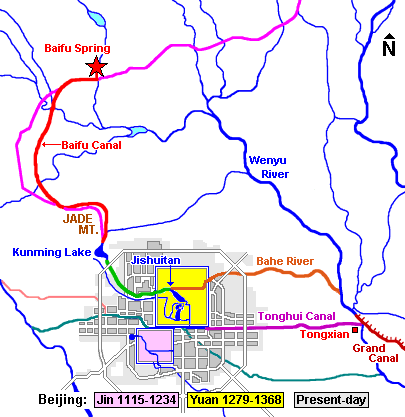Introduction (2) - Main Waterflow
![]()

Guo Shou Jing faced three major challenges. First he needed to get the water from Baifu to Beijing in a steady and controllable downward gradient; then he had to regulate water levels to ensure a steady depth inside and outside of the capital; finally, he had to find a way of connecting the water system to the Grand Canal to ensure the all important food and timber supplies to the city. All of this of course with a constant flow of water to avoid flooding and diseases.
He solved the first challenge by constructing the thirty kilometer long Baifu Canal, which sloped gently in a curve caressing the foot of the western Jade Mountains.
He achieved the second objective of a steady water level by having the Baifu Canal empty into an enlarged, natural lake, today's Kunming Lake at the Summer Palace, using the lake as a regulating pool. The water was then channeled into another regulating pool in the western, central part of the capital around today's Jishuitan.
The objective of connecting the water system to the Grand Canal was attained by excavating a new canal, the Tonghui Canal, beginning at the eastern city moat of Beijing and ending at Tongxian, the northernmost point of the Grand Canal.
Water flowed from Jishuitan to Tongxian two ways: Either through the eastern moat of the Imperial City and then straight east along today's Chang'an Avenue or through a new canal running straight east from Jishuitan into Bahe River, emptying into Wenyu River, which itself joined the Grand Canal at Tongxian.
Oh, and the constant water flow? Some twenty-four sluice gates painstakingly regulated the water level, section by section.